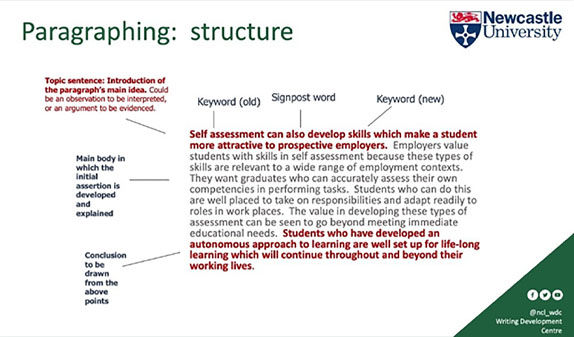Paragraphing
Find out how to structure an academic paragraph.
Academic Writing has its own conventions, not just in terms of style and language, but also structure, and the use of paragraphs is one of those conventions.Paragraphs don’t just make a text easier to read by breaking it up on the page. They are a key tool in creating and signposting structure in academic writing, as they are the building blocks of an argument, separating each point and showing how they link together to form the structure. They also have a characteristic structure of their own.

Paragraphs and points
A common piece of advice is ‘one point per paragraph’. This can be a little hard to put into practice – what counts as ‘a point’? The whole assignment could be said to be making a point, and each sentence also makes a point. Another way to think of it is that a point in this sense is a statement of argument or observation that contributes a significant and essential step in your whole structure, without which your conclusion will be weakened. A point like this can’t stand on its own without being further unpacked with evidence, explanation, interpretation etc, which is the job of the rest of the paragraph. You should be able to get the overall gist and structure of an academic text by just reading the first line of each paragraph.
Topic sentences
This point is usually the first (in some cases the second) sentence of the paragraph, commonly known as the topic sentence. The point made is usually an argumentative statement which needs to be demonstrated or an observation which needs to be interpreted or explained (the former is more common in Arts, Humanities and Social Sciences; the latter is more common in the sciences, but they can be found in both). The topic sentence introduces the main idea of the paragraph, usually with a key word which echoes the signposting language from the introduction so the reader recognises it. It also moves from what we know (the old keyword) to the new information (the new keyword), showing how the paragraph builds on what has gone before. It also indicates how it connects to the previous paragraph with a signpost word. This linking should be as brief as possible, as the longer your reader has to wait or the more they have to search for the new idea, the more confused they are likely to become.
Paragraph structure
Academic paragraphs work like court reports rather than murder mysteries; start with the end result and then explain how you got there, rather than taking the reader on an exploration with the purpose only revealed at the end. One simple model for paragraph structure is PEEL: Point, Evidence, Evaluation, Link (to the assignment topic or next paragraph). This is a good starting point, but you may find it too rigid and restrictive for what you need to do, or too clumsy and repetitive in constantly linking back or forward. Look at some of the paragraphs in the academic books or articles you’re reading and see how they are structured and how often they fit this model, and how they vary. Average paragraph length varies depending on your subject - Arts, Humanities and Social Sciences tend to use longer paragraphs than in the sciences.
Sentence structure
In English, the reader prioritises the information which is at the start of the sentence (they are front-loaded). Sentence length varies according to personal taste and discipline convention, but overly long sentences can mean that later elements get overlooked or the sentence coherence breaks down. If your sentence contains several important elements, then it might be best to split into two or more sentences so that each one gets its own spotlight. You can use signposting words to make the connection between them clear.
Compare these two versions. Which is better?
In English, sentences are ‘front-loaded’ so the most important information appears early on, and later information may be lost, meaning that writers might separate very long sentences and use signpost words to demonstrate the link.
In English, sentences are ‘front-loaded’ so the most important information appears early on. Later information may be lost as a result. Writers might therefore separate very long sentences and use signpost words to demonstrate the link.
Troubleshooting
Problem 1
- You’re not sure which is your topic sentence.
- Your reader gives you the feedback that your point isn’t clear (or that your writing is too descriptive).
Your main point is likely to be buried somewhere in your paragraph, or there isn’t a clear focus. This could be an issue with planning, or that you are still working your ideas out as you write. Ask yourself: if you could only keep one sentence from each paragraph, which one would it be? That is most likely an idea, argument or observation of your own rather than from your reading. This is likely to be your topic sentence, and should be placed at the start of your paragraph. Your reader should be able to follow your overall structure by reading the first line of each paragraph, to capture your points. If the first line of your paragraph is just a descriptive fact or quote from someone else, then they aren’t going to get a sense of your argument.
Problem 2
- Your paragraphs are very long.
- More than one of your sentences could be your topic sentence.
You may have some less relevant material which isn’t essential to making your point, or your paragraph may be making two related points rather than one. If you ask ‘if I could only keep one sentence from this paragraph, which would it be?’ and can’t decide between two sentences, then you may have two points which would be better developed separately in two paragraphs. You could also look at each sentence and decide if it’s necessary or just nice to have, and whether your overall point would be undermined if you removed it, or if it just adds interest but is not strictly essential.
Problem 3
- Your paragraphs are very short.
- Your feedback suggests that you need to ‘unpack’ or ‘expand’ your points.
You may have an isolated fragment which on your plan looked like it might be enough for a paragraph but didn’t work out being very much when you came to write it up. This would be better integrated into another paragraph if it fits, or cut if it doesn’t. You may instead have skipped some of your reasoning, not developing your point fully with all of the evidence and explanation needed, and instead assuming that your reader is following you. In this case, try analysing what you have written and after each sentence (or part of a sentence), identify what questions the reader might ask about that to be convinced of it, such as ‘what does that mean? How do you know? Why / how does that happen? What is the significance of that? How does that prove your point?’ If you haven’t answered any of the questions that occur to you, you may need to expand on that aspect more fully.
